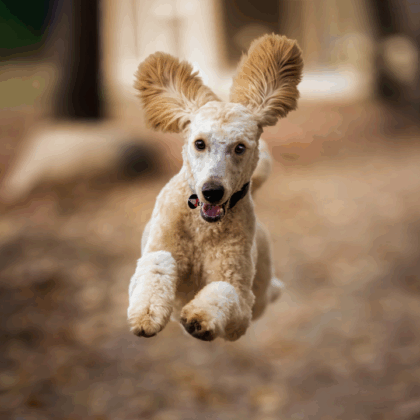Most reactivity protocols start with the trigger. Keep the dog under threshold. Counter-condition. Desensitize. Click and treat when the dog looks at you instead of lunging.
All good techniques. But they’re often starting too late in the process.
By the time that reactive dog sees another dog across the parking lot, his arousal is already climbing. His nervous system is already hijacked. And you’re asking him to make good choices with the part of his brain that’s least available in that moment.
The Foundation Lives at Home
Think about what we’re asking: “In your most aroused, stressed, triggered state, I need you to access self-regulation that you’ve never practiced when aroused.”
It’s like asking someone to perform surgery during their first code blue. The skills need to be established first, practiced extensively in lower-pressure situations, until the neural pathways are strong enough to access under stress.
This is where Attentive Cooperation/Puppy Politeness Poker offers something elegant. It teaches self-regulation throughout the dog’s normal day, using things the dog actually cares about. Not training treats or toy rewards, but real life rewards: going through the door to the yard, getting the food bowl, coming back in from outside, having the crate door opened, getting into the car for a ride.
For many dogs, these moments provoke genuine arousal. Your reactive dog bounces in his crate every morning, anticipating being let out. His arousal is legitimately high. This is not a calm, thoughtful dog.
This is exactly the training opportunity you need.
How It Works
You approach the crate, touch the door, and tell him what you need him to do. If he chooses to keep dancing and barking, he’ll miss the cue. Your hand comes off the crate for a few seconds before you try again.
He’s learning that when you approach the crate, the fastest way to success is to dial down his arousal and focus on what you’re asking. In addition to getting out of his crate, he gets other benefits: learning self-regulation, practicing attentive cooperation, and not practicing unproductive arousal. And it all goes into the neural circuitry in that developing brain.
The Math That Changes Everything
Here’s where the magic happens. My puppy Baloo has a minimum of 50 cooperation opportunities every day just on doors and gates. That’s 350 quick and successful practice sessions per week where he’s learning to modulate his arousal in order to earn something he wants.
He’s not learning to suppress his arousal or pretend he’s not excited. He’s learning to stay in his Think & Learn Zone even when aroused. He’s building strong neural pathways for “I’m excited AND I can still think.”
This is practiced thousands of times before we ever approach a triggering situation.
Using Arousal as the Teacher
The strength of this approach for reactive dogs lies in using the dog’s own arousal to teach self-regulation. Traditional approaches often try to keep arousal low, working constantly to stay under threshold.
Puppy Politeness Poker acknowledges that arousal is part of life. Your reactive dog will get aroused. The question is: can he still think when that happens?
By practicing self-regulation in naturally arousing (but not triggering) situations throughout the day, the dog learns this is possible. He experiences success at modulating his own nervous system. He discovers that he can be excited and still make good choices.
For Trainers
This means reframing how we approach reactivity cases. Before we start the careful trigger exposure work, we build the foundation. We teach clients how to use Puppy Politeness Poker at home, in the dog’s normal environment, with the dog’s normal daily routine.
We create thousands of successful repetitions of attentive cooperation and self-regulation. We build strong neural pathways. We teach the dog that arousal doesn’t mean loss of control or loss of mind.
Only then do we approach the triggers. And when we do, we’re working with a dog who has the foundational skills to succeed.
The difference is profound.

